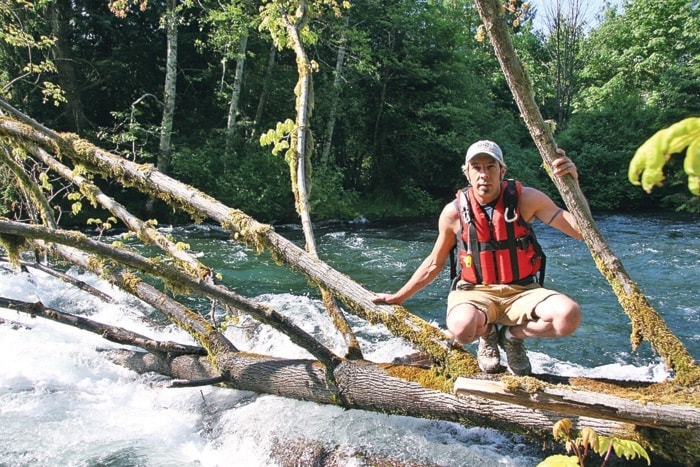A December mudslide on the Campbell River continues to compromise the safety of recreational users of the river habitat.
Water levels on the river are high and the flow is powerful. Reaching out into the currents like the fingers of a demon tree in a horror cartoon are the trunks and branches of trees. And their catch could be swimmers and people floating down the river on inner tubes and air matresses.
Just down from the John Hart Generating Station are trees that were swept down by a slump that took out a portion of the Canyon View Trail. They are now creating a potential hazard for people who like to float or snorkel down the river.
The danger worries Jamie Turko, a swift-water rescue specialist with Campbell River Search and Rescue and a river rafting guide.
“This is a hazard,” Turko said Wednesday crouched on a maple tree anchored on shore but spanning most of the way across a channel on the north side of the river.
“It’s called a strainer. It allows water to flow but not solid objects,” he said. “The main current comes right down and pushes right into this big old maple here that’s fallen in. Any of the tubers or swimmers or air mattresses are going to be sucked right into it. Somehow we’ve got to find a way to get this out for public safety.”
Turko has been in discussion with BC Hydro, the Quinsam Hatchery, DFO and other river users about the situation. Everyone agrees it’s a hazard and are willing to resolve it with public safety in mind. When water levels drop – expected to be sometime soon – Turko wants to take the trees out of their current situation and move them to where they’re less of a danger to the public.
But Turko is aware that the trees are part of the natural process and create fish habitat on the river. That’s why the plan is to move them to point where they can parallel the river course but not stick out into it.
Turko said that the river is used by “young kids, teenagers, even some adults” and they are not as aware of the dangers and how to avoid them. Little thought is given to preparing for swiftwater hazards. Most people just think, “It’s a hot day, let’s float down the river,” unaware of the potential danger.
“I know that on nice, hot sunny days everybody wants to get out on the water and cool down,” Turko said. “It is a favourite past time of mine. I did it as a kid and I still do it today.”
But Turko wants his time spent on the water to be fun, not as a Search and Rescue volunteer.
“We do quite a few swiftwater call outs on the river and I don’t want to do any more than I have to on the Campbell River this year,” he said.
Indicating the “strainer,” Turko said, “If a person were to float into this or swim into it basically, with the current, it sucks them down underneath it and they get pinned in all the solid branches and broken branches underneath. And there they stay. With the force of the current ,you’re not going to be able to get out of it unless you know how to get out of it.”
Besides at the slump, which occured after a heavy rainfall last December and required a portion of the Canyon View Trail to be re-routed, there are other wood hazards along the Campbell River due to the high water level. Logs have been swept out into the main course of river get stuck on rocks. With the speed of the water, these can be hard to avoid.
